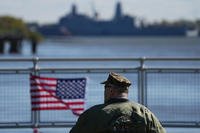The U.S. Army is so worried about climate change, which it has identified as a national security threat, that it issued a new directive Sept. 11 requiring planners and managers to establish resilience measures against natural disasters, according to a service news release.
Recent natural disasters, from California wildfires to hurricanes in the Southeast, have posed threats to Army operations and installations, resulting in the service's move to safeguard valuable assets and minimize the impact on readiness.
Under the new directive, Army installations will be provided with instructions to strengthen resilience against natural disasters, which include but are not limited to flooding, drought, desertification, rising sea levels, extreme heat and thawing permafrost, said Stephen Dornbos, science and technology policy fellow in the Office of the Assistant Secretary of the Army for Installations, Energy and Environment, or ASA (IE&E).
Read Next: The Air Force Has Already Flown a Secret Plane That Could Be Its Next Fighter
"Climate change has already had a big impact on Army installation infrastructure and threatens to degrade mission readiness. I think it's going to continue to have an increasingly large impact going forward," Dornbos, who served as professor of geosciences at the University of Wisconsin-Milwaukee for 15 years, said in a statement.
"There are a lot of concerns about wildfires in California and energy supply being threatened," he added. "There are adaptation strategies that installations could use to better prepare themselves."
Congress already requires military posts to consider climate threats in infrastructure planning and design, according to the release. The new Army directive directs installation commanders to develop emergency plans for extreme weather events and to add climate change projection analysis tool results to infrastructure plans, policies and procedures.
"This practice will enhance installation readiness and safety because it informs the installation master planning process and facility design requirements," Alex A. Beehler, assistant secretary of the Army for ASA (IE&E), said in the release. "In the event of a climate-related event, our Army installations will be better prepared to provide the critical capabilities essential to the Army's ability to deploy, fight and win our nation's wars."
The directive will guide commanders to protect soldiers and their families from health and safety impacts, Dornbos added.
The U.S. Army Corps of Engineers has set up a web-based Army Climate Assessment Tool, which will help installations assess exposure to weather-related threats, such as heat-related illnesses, and predict future climate impacts.
The Army Climate Resistance Handbook, published last month, will provide a quick reference with more details on climate and extreme weather resilience measures for installation managers.
The directive instructs commanders to tailor climate resilience measures against local threats, including tracking power and water levels, the release states.
The Army Climate Assessment Tool will be updated with new data and climate projections over time, Dornbos added.
Climate change could make military posts more vulnerable to adversary attacks, weakening the Army's ability to project power, Dornbos said.
"The motivation is to protect critical assets and ensure installation mission readiness in the face of climate and extreme weather threats," he added.
"Installations need to start engineering for the future," Dornbos said. "Designing based on historical conditions is insufficient to engineer buildings that will be serving the Army in 20 or 30 years, when we will have increasingly damaging weather events, so I think the timing of this is right."
Army installations have been affected by a number of major weather events in recent years. Hurricane Florence caused catastrophic flooding near Fort Bragg, North Carolina, in September 2018. In 2011, wildfires burned more than 11,000 acres at Fort Hood, Texas. Wildfires swept the post again in 2018, damaging training grounds and canceling field training and live-gunnery exercises. And thawing permafrost threatens the three Army posts in Alaska.
-- Bing Xiao can be reached at bingxiao2020@u.northwestern.edu.
Related: Trump Presents Distinguished Flying Cross to 7 Guardsmen for Wildfire Rescues












